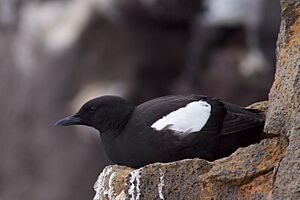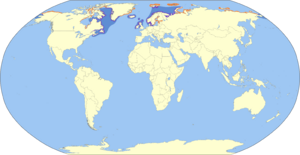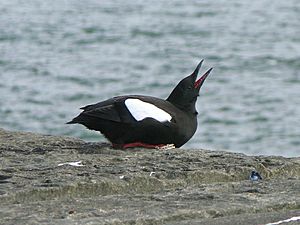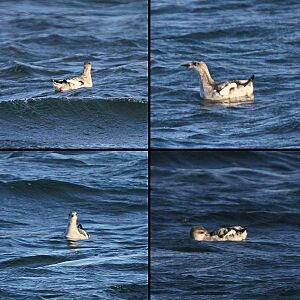Black guillemot facts for kids
Quick facts for kids Black guillemot |
|
|---|---|
 |
|
| Black guillemot resting on a cliff in Reykjanes, Iceland | |
| Conservation status | |
| Scientific classification | |
| Genus: |
Cepphus
|
| Species: |
grylle
|
 |
|
| Synonyms | |
|
|
The black guillemot or tystie (Cepphus grylle) is a cool seabird about the size of a pigeon. It lives along the northern Atlantic and eastern North American coasts. Many black guillemots stay in their home areas all year. However, some from very cold northern places fly south for the winter.
You can often spot these birds near rocky shores, cliffs, and islands. They usually hang out alone or in small groups of pairs. Black guillemots mostly eat by diving deep into the ocean. They look for fish, crabs, and other small creatures on the seafloor. Scientists say they are a species of "least concern," meaning they are not currently in danger.
Both male and female black guillemots look very much alike. In summer, they are mostly black with a big white patch on their wings. Their beak is black and thin, and their feet are a bright coral-red. In winter, their belly turns white, and their back becomes light gray with white stripes.
Black guillemots nest alone or in small groups. Their breeding season starts in late February or early May. They usually build nests in cracks in cliffs or between rocks, above the high tide line. Many don't build a true nest, just laying eggs on the ground. They typically lay two eggs, which are dull white or pale green with dark spots. Both parents take turns sitting on the eggs for about 28 to 32 days.
When chicks hatch, they are covered in black fuzz. Their parents care for them until they are 30 to 40 days old. After that, the young birds can fly and are ready to be on their own. By age three or four, they often return to the same colony where they were born.
The name Cepphus comes from an old Greek word for a pale waterbird. The name grylle was what people in Gotland, Sweden, called this bird when Carl Linnaeus visited in 1741. The English word "guillemot" likely comes from a French name, possibly related to "William."
Contents
What do Black Guillemots Look Like?
Black guillemots are medium-sized birds. Adults are usually about 30 to 32 centimeters (12 to 13 inches) long. Their wings can spread out to 52 to 58 centimeters (20 to 23 inches) wide. They weigh between 300 to 460 grams (10 to 16 ounces). Males and females look the same.
Summer and Winter Feathers
The common name "Black Guillemot" comes from their striking black summer feathers. These feathers are completely black, except for a large white patch on the top of their wings. In summer, their legs, feet, and the inside of their mouth are a bright coral-red. Their beak is black.
In early fall, they change their feathers. Their upper body becomes striped with light gray and white. Their head turns pale gray, and their belly becomes white. Their legs and feet are a lighter red. They still keep their white wing patch, black beak, and red mouth. During breeding season, they make a high whistling sound. Their bright red mouth is very noticeable then.
Young Birds
Young black guillemots are easy to spot. Their white wing patch has gray or brown spots. You can see these spots even from far away.
Where do Black Guillemots Live?
Black guillemots live all around the northern parts of the world. You can find them in the North Atlantic and Arctic oceans. They breed in areas between 43° and 82° North. There are five different types, or subspecies, of black guillemots. Each lives in a different part of this wide range.
Their Homes Across the World
In North America, they live as far south as the Gulf of Maine. They also live along parts of the northern coast of North America, reaching Alaska. In Europe and Asia, they are found from the British Isles and northward across the northern coast of Asia. They are one of the few birds that breed on Surtsey, a new volcanic island in Iceland.
About 40% of all black guillemots breed in the far north, where the biggest groups are found. Another 30% live in slightly less cold northern areas. The last 30% live in cooler, but not freezing, waters. In winter, some birds from the far north have to fly south because of the ice. But in warmer places, these birds usually stay put all year.
Their Favorite Spots
Black guillemots usually stick to rocky shores. They use cliffs, cracks, and large rocks for their nests. They hunt for food in the waters close to shore. Compared to other similar birds, they don't fly far from their colony to find food. During breeding season, they mostly hunt in waters less than 50 meters deep. In winter, they might go a bit farther out.
How do Black Guillemots Behave?
Black guillemots are birds that hunt for food near the coast. Their diet mostly includes creatures that live on the seafloor or in kelp forests.
Hunting for Food
They dive between 15 to 20 meters (50 to 65 feet) deep to catch their prey. They can even dive as deep as 43 meters (140 feet)! They use their wings to swim underwater and their feet to steer. Small prey are swallowed whole while still underwater. If the prey is larger, they bring it to the surface. They soften it in their beak before swallowing it whole.
When feeding their chicks, guillemots bring back one piece of food at a time. This means parents have to hunt close to their nest. Chicks need a lot of food with plenty of energy every day. Black guillemot diets include fish like sculpins, butterfish, and herring. They also eat jellyfish, snails, and small crabs.
What Threats do Black Guillemots Face?
Black guillemots face several dangers. They can be hunted by animals like American Mink, Great Skuas, gulls, and otters. Other threats come from animals that are not native to their area, such as brown rats and wild cats. For example, a large group of about 2600 black guillemots on an island in the Baltic Sea was wiped out by American Mink in the early 2000s.
Because black guillemots hunt close to shore, they are more exposed to pollution than seabirds that live farther out in the ocean. Other problems for them include getting caught accidentally in fishing nets, losing their homes, and changes in climate.
Images for kids







